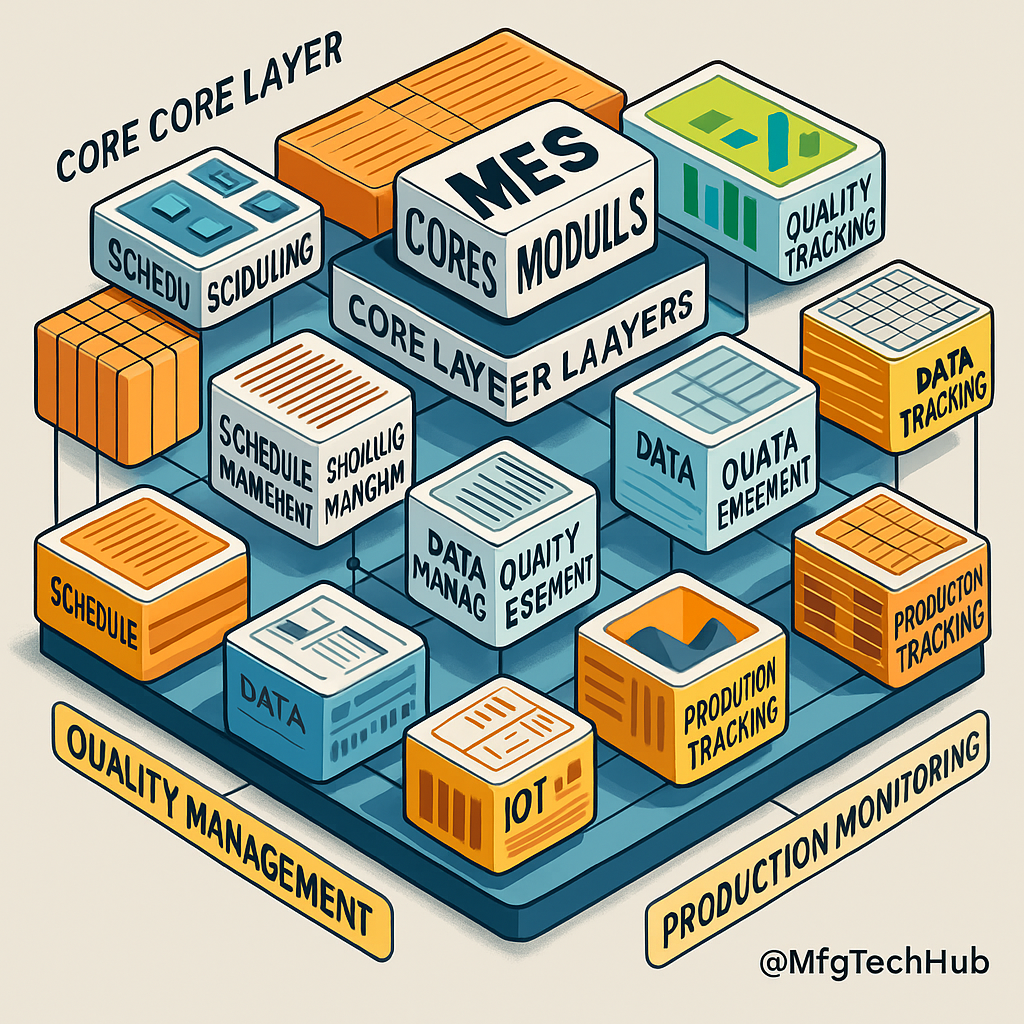MES Architecture: System Layers and Hierarchy

What is MES System Layers and Hierarchy?
The MES architecture is organized into distinct layers, each responsible for specific functions. These layers enable MES to integrate with higher-level systems like ERP and lower-level systems like SCADA, PLCs, and IoT devices. By structuring functions across different levels, manufacturers ensure clarity, efficiency, and adaptability in operations.
- Enterprise Layer: Integrates MES with ERP systems for production planning and business operations.
- MES Core Layer: The heart of MES, responsible for executing production processes, tracking, and monitoring.
- Integration Layer: Bridges the gap between shop floor devices and MES.
- Shop Floor Layer: Comprises machines, sensors, IoT devices, and control systems like SCADA and PLCs.
System Layers in MES Architecture

1. Enterprise Layer
The enterprise layer connects MES to broader business systems like ERP (Enterprise Resource Planning), CRM (Customer Relationship Management), and SCM (Supply Chain Management). It ensures production activities align with business objectives and customer demand.
- Function: Acts as the decision-making hub that links business strategy with operational execution.
- Key Responsibilities:
- Receives production orders, plans, and schedules from ERP.
- Communicates back data such as production status, material usage, and quality outcomes.
- Example: An ERP system issues a production order for 10,000 units. The MES receives this plan and orchestrates resources on the shop floor to deliver on time while updating ERP about progress.
2. MES Core Layer
The core layer is the operational brain of the system. It is where most manufacturing decisions are executed, monitored, and optimized. Without this layer, manufacturers would face delays, inconsistencies, and errors.
- Function: Executes the primary functions of MES, including production scheduling, quality control, and inventory tracking.
- Key Responsibilities:
- Maintains production records and generates compliance reports.
- Ensures resources and machines are effectively utilized.
- Provides supervisors with real-time dashboards for monitoring.
- Modules:
- Production Scheduling: Allocates machines, labor, and tools efficiently.
- Quality Management: Detects defects early and ensures compliance with standards.
- Inventory Management: Tracks raw material use, WIP, and finished goods.
Example: In a pharmaceutical company, the core layer ensures each production batch follows strict FDA compliance by documenting all steps, monitoring cleanroom conditions, and maintaining digital batch records.
3. Integration Layer
The integration layer serves as a bridge between the MES core and physical devices on the shop floor. It ensures machine data is translated into a format MES understands and vice versa.
- Function: Facilitates communication between MES and systems such as SCADA, PLCs, and IoT-enabled devices.
- Key Responsibilities:
- Translates high-level work orders into machine-specific instructions.
- Collects real-time data such as machine status, temperature, or cycle times.
- Technologies Used: OPC-UA, MQTT, REST APIs, and industrial communication protocols.
Example: When MES instructs a packaging machine to switch from small to large cartons, the integration layer translates this request into commands that the PLC can execute instantly.
4. Shop Floor Layer
This is the physical execution layer that involves direct interaction with machines, tools, robots, and human operators. It represents the tangible side of manufacturing where real transformation of raw materials into finished products occurs.
- Function: Executes the commands received from MES and provides feedback data.
- Key Responsibilities:
- Ensures machines operate as instructed.
- Collects raw data such as production counts, energy consumption, or defect detection.
- Example: A PLC adjusts conveyor speeds or robot arms based on MES scheduling to balance production flow.
System Hierarchy in MES

The MES hierarchy aligns with the ISA-95 Standard, a global framework for integrating enterprise and control systems. This model describes how data and control flow from the shop floor up to business planning systems.
- Level 4: Business Planning and Logistics
- Systems: ERP, CRM.
- Function: Long-term planning, resource allocation, and customer order management.
- Level 3: Manufacturing Operations Management (MES)
- Systems: MES Core.
- Function: Execution, tracking, and optimization of production processes.
- Level 2: Supervisory Control
- Systems: SCADA.
- Function: Provides real-time process monitoring and operator supervision.
- Level 1: Process Control
- Systems: PLCs, DCS.
- Function: Controls machine operations and automates repetitive tasks.
- Level 0: Physical Processes
- Components: Machines, sensors, actuators.
- Function: The actual physical transformation of raw materials into products.
Benefits of MES Layered Architecture
The layered design of MES is not just technical but strategic, offering multiple advantages:
- Seamless Integration: Ensures smooth data flow between enterprise systems and shop floor operations, breaking down silos.
- Improved Scalability: Modular structure supports future expansions without disrupting existing operations.
- Enhanced Visibility: Provides real-time monitoring of performance metrics across the plant.
- Operational Efficiency: Reduces manual errors and streamlines production by automating workflows.
- Standardization: Aligns with international models like ISA-95, making it easier for global organizations to implement unified systems.
Challenges in MES Layered Architecture
Despite its advantages, layered MES comes with challenges that manufacturers must address:
- Complex Integration: Linking MES with multiple systems such as ERP, SCADA, and IoT can be technically challenging and time-consuming.
- Data Management: Handling the enormous amount of real-time production data requires robust databases and processing systems.
- Implementation Costs: Initial deployment, licenses, and training can be costly, especially for small manufacturers.
- Change Management: Employees may resist new workflows, requiring training and awareness programs.
Conclusion
The architecture of a Manufacturing Execution System demonstrates why MES is central to Industry 4.0 transformation. By connecting enterprise-level decision-making with shop floor execution, MES ensures that strategy translates into action with accuracy and speed. Its layered structure — spanning enterprise planning, core operations, integration middleware, and physical shop floor systems — provides flexibility, control, and visibility.
As industries evolve, future MES architectures will increasingly integrate AI, edge computing, digital twins, and predictive analytics. These advancements will not only streamline processes but also empower organizations with real-time insights, leading to smarter, more resilient, and more competitive manufacturing ecosystems worldwide.
